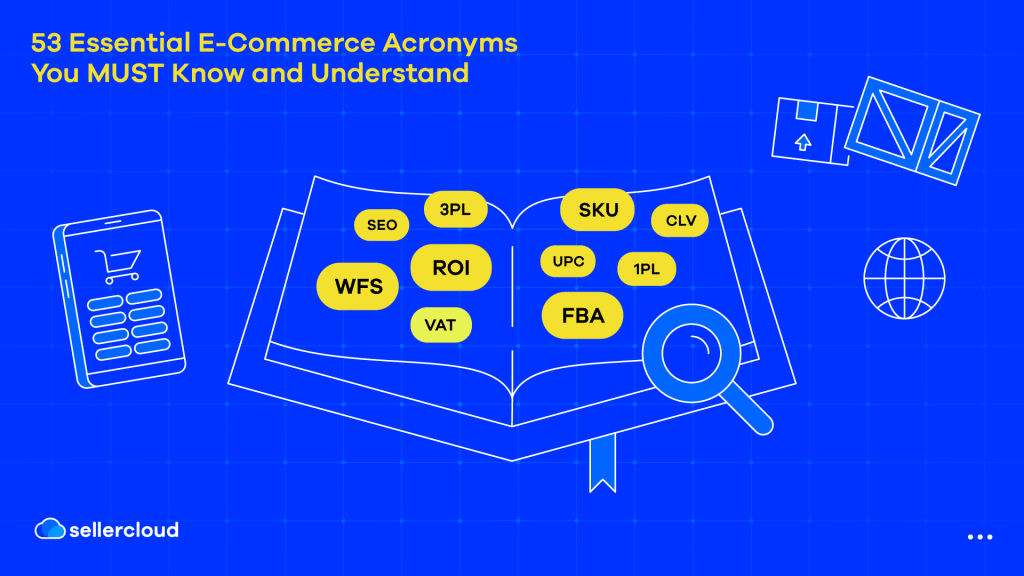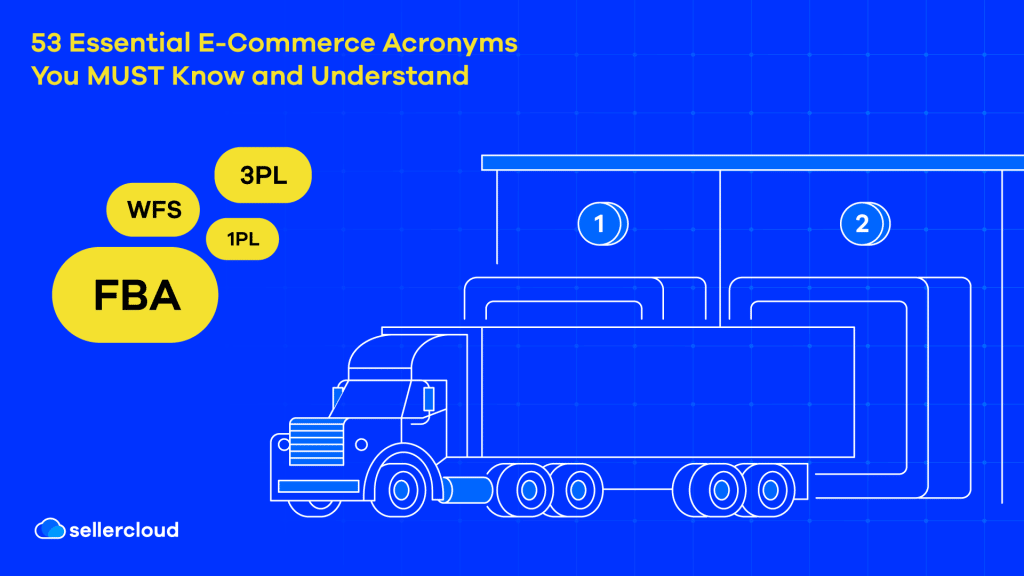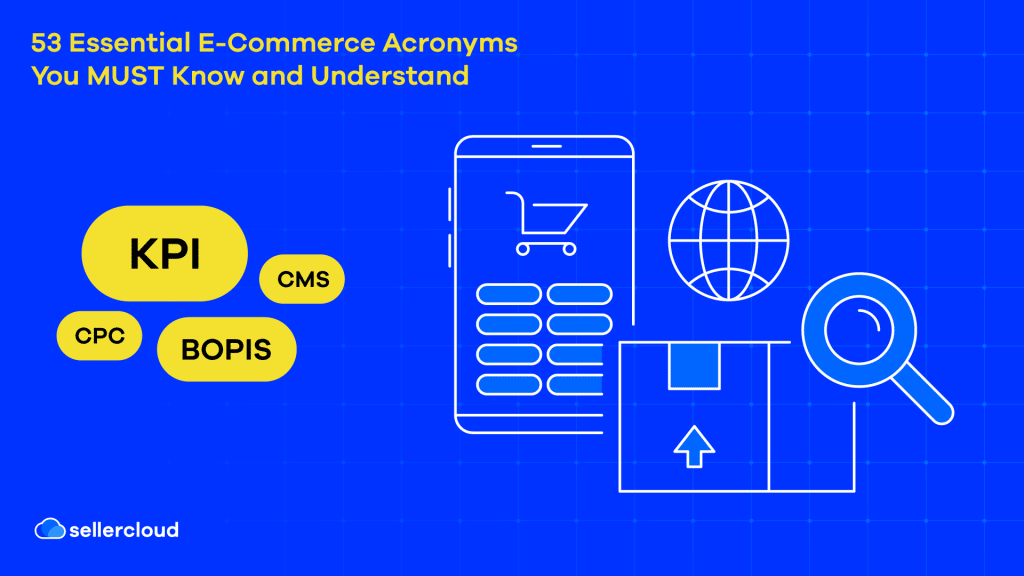
The world of omnichannel ecommerce uses many acronyms and abbreviations in workflows, strategic planning, and reporting. As such, an understanding of ecommerce abbreviations is critical to running a smooth and efficient online sales business. To ensure you have the necessary knowledge, we have compiled an ecommerce acronym dictionary of the most often used and important terms.
Go Over Our Ecommerce Cheat Sheet
- 1PL – First-Party Logistics
- 2PL – Second-Party Logistics
- 3PL – Third-Party Logistics
- 4PL – Fourth-Party Logistics / 5PL – Fifth-Party Logistics
- AOV – Average Order Value
- API – Application Programming Interface
- ASIN – Amazon Standard Identification Number
- AVS – Address Verification Service
- B2B – Business to Business
- B2C – Business to Consumer
- BOPIS – Buy Online Pickup In Store / BORIS – Buy Online Return In Store
- CAC – Customer Acquisition Cost
- CLV – Customer Lifetime Value
- COGS – Cost of Goods Sold
- CPA – Cost Per Acquisition
- CPC – Cost Per Click
- CPM – Cost Per Thousand Impressions
- CRM – Customer Relationship Management
- CRO – Conversion Rate Optimization
- CTA – Call to Action
- CTR – Click Through Rate
- D2C – Direct to Consumer
- EDI – Electronic Data Interchange
- FBA – Fulfillment by Amazon
- FBM – Fulfillment by Merchant
- FIFO – First-In-First-Out / LIFO – Last-In-First-Out
- ITR – Inventory Turnover Ratio
- KPI – Key Performance Indicator
- MAP – Minimum Advertised Price
- MCF – Multi-Channel Fulfillment
- MPN – Manufacturer Part Number
- OOS – Out of Stock
- P&L – Profit and Loss
- PO – Purchase Order
- POS – Point of Sale
- PPC – Pay-Per-Click
- PPS – Pay-Per-Sale
- RMA – Return Merchandise Authorization
- ROI – Return on Investment
- SaaS – Software as a Service
- SEM – Search Engine Marketing
- SEO – Search Engine Optimization
- SKU – Stock-Keeping Unit
- SLA – Service-Level Agreement
- TOS – Terms of Service
- UPC – Universal Product Code
- VAT – Value Added Tax
- WFS – Walmart Fulfillment Services
- WMS – Warehouse Management System
- WPID – Walmart Product Identification
1PL – First-Party Logistics
1PL is an ecommerce handling model where the business is responsible for its end-to-end logistics. Warehousing, order processing, shipping, and delivery are all handled internally without external support. This is typically a rarity in ecommerce due to the distribution and delivery challenges associated with online sales. Few omnichannel ecommerce brands have the resources to execute a cost-effective 1PL strategy.
2PL – Second-Party Logistics
2PL is a largely self-sufficient ecommerce model. The business handles warehousing, orders, and fulfillment but relies on external shipping and distribution partnerships to both acquire and ship out products. This can be a particularly profitable business strategy for ecommerce businesses that want to maintain brand control while also supporting the agility to scale and grow.
Running your own ecommerce warehouse is both possible and affordable as long as you have the means to manage inventory, space, and employees effectively. This is why a warehouse management system (WMS) like Skustack is a critical component for 2PL success.

3PL – Third-Party Logistics
3PL is a model for outsourcing ecommerce order fulfillment and, in some cases, supply chain orders. Ecommerce businesses ship products in bulk to 3PL partners, who handle the picking, packing, and shipping of orders when they come in. Some marketplaces offer this type of logistical support directly—for instance, Amazon with FBA (Fulfillment By Amazon) and the Walmart Marketplace with WFS (Walmart Fulfillment Services).
There are also 3PL providers that operate independently of specific channels. The main benefit and allure of 3PL partnerships is that they allow businesses to scale without having to navigate the burdens of scaling warehousing, fulfillment, and shipping simultaneously. Descartes Sellercloud integrates with the industry’s best 3PL providers to ensure you can get the most out of your logistics partnerships and optimize your business’s fulfillment capabilities.
4PL – Fourth-Party Logistics/5PL – Fifth-Party Logistics
4PL and 5PL services are relatively new concepts. In simplest terms, 4PL and 5PL companies contract 3PL providers and other support partners on behalf of your business. They serve as logistical ‘concierges’ more than actual logistical support providers themselves. Ultimately, significant costs and risks associated with 4PL and 5PL are unnecessary if you have a reliable ecommerce platform and management plan in place.
In nearly every instance, it is more reliable and affordable to establish and maintain your own 3PL relationships than outsourcing the responsibility to a 4PL or 5PL company.
AOV – Average Order Value
Average Order Value describes the average dollar amount spent per order. This transaction-focused metric is critical for evaluating product prices, channel performance, customer behavior, advertising potential, seasonality, and potential areas for cross-selling and upselling. Increasing AOV should be a priority for all ecommerce businesses.
API – Application Programming Interface
APIs are digital communication protocols that allow for data requests and transfers between systems (both internally and with external companies). They are quick, secure, and efficient pipelines for information. As such, API-level access is often the preferred method when integrating third-party partners’ code and systems into your own business’s platform and workflows.
ASIN – Amazon Standard Identification Number
Amazon assigns a unique code made up of 10 letters and/or numbers for each product listed on its marketplace. The ASIN is automatically created and assigned when a new product is uploaded to Amazon’s catalog.
If you are listing a product that already exists on a particular Amazon marketplace, the existing ASIN is used. Descartes Sellercloud’s integration with Amazon makes it simple to assign and manage the ASINs for all the products you sell.
AVS – Address Verification Service
AVS is a key method of preventing ecommerce fraud. A customer’s billing address is checked to ensure the payment method is valid before allowing a transaction to complete. The other benefit of an AVS is that it prevents shipping errors.
By validating order destination addresses ahead of time, you reduce the risk of costly fulfillment mistakes and dissatisfied customers. To help ensure shipping accuracy, Shipbridge supports address validation for any and all shipments.
B2B – Business to Business
B2B ecommerce is the sale of products from your business to another. Orders typically involve multiple stakeholders, and, as such, the negotiations and sales cycles tend to be significantly longer than when selling to consumers. That said, the order values and order volumes are usually significantly higher than with B2C sales conversions.
Because B2B ecommerce differs from B2C ecommerce in significant ways, it is important to establish unique strategies and workflows when establishing and scaling the B2B side of any ecommerce brand. This can help a business avoid many of the common mistakes many companies make when entering into B2B sales.
B2C – Business to Consumer
B2C ecommerce is the sale of products from a business directly to a consumer. This can be done through third-party channels like online marketplaces or directly to consumers through a business’s own website or storefront.
BOPIS – Buy Online Pickup In Store/BORIS – Buy Online Return In Store
The buy online, pick up in store (BOPIS) ecommerce business model combines the comfort and security of online shopping with the convenience of brick-and-mortar retail. Customers can make a BOPIS purchase, and the order is either fulfilled and shipped to a nearby retail location or picked directly from retail shelves.
Customers then are notified to retrieve the item either from a specified in-store location or by taking advantage of a curbside pickup option. Similarly, many companies offer customers the opportunity to return merchandise purchased online to a retail store instead of packing and shipping their unwanted or damaged products.
Many stores and ecommerce marketplaces have made it a point to add and/or expand their BOPIS/BORIS options as they gained popularity throughout the COVID-19 pandemic. Descartes Sellercloud supports BOPIS through our integration with Amazon’s Local Selling program.
CAC – Customer Acquisition Cost
Customer acquisition cost is the sum of all the costs and expenses associated with acquiring a customer. These costs include warehousing, fulfillment, marketing, and labor. CAC is a crucial metric to consider when setting product prices, diversifying marketplace exposure, and assessing advertising and marketing value.
CLV – Customer Lifetime Value
Sometimes referred to simply as lifetime value (LTV), CLV is the total gross profit your business has earned from a single customer over the entirety of their relationship with your business. This calculation should include expenses like returns, acquisition costs, and service costs that can be directly attributed to the specific customer’s purchases.
CLV provides valuable insights that can help set budgets and expectations for other current and future customers. For example, having a solid grasp on CLV means you can make data-driven decisions about aspects of your marketing strategy, like customer retention, advertising, cross/upselling, and channel performance.
Repeat customers are key to scaling an ecommerce brand; as such, CLV is a metric that always deserves particular attention.
COGS – Cost of Goods Sold
COGS is the total of how much it costs to acquire and store the products you sell. Unlike a simple cost-per-unit value that can be derived directly from your vendor purchase orders, COGS takes into account the money spent to move products to and between your warehouses, the expenses associated with storing a product prior to sale, and the taxes and fees associated with any of the aforementioned costs.
Descartes Sellercloud’s robust reporting features are optimized to make it easy to find and calculate these values for all the products you sell.
CPA – Cost Per Acquisition
Cost per acquisition (CPA) is the sum of all the costs associated with moving a customer through the entire sales funnel, from initial product/brand awareness through a completed sale. This makes CPA one of the most important metrics for assessing the effectiveness and value of ecommerce marketing efforts. It is also a key component in determining accurate CLV figures.
CPC – Cost Per Click
Cost per click (CPC) is a digital marketing metric that assesses the cost associated with a customer clicking on a particular advertisement or marketing link compared to the sales conversions that result from those clicks. When opting for Pay-Per-Click (PPC) marketing campaigns, CPC is a key to determining if the revenue brought in justifies the cost of the ad buy.

CPM – Cost Per Thousand Impressions
Like CPC, CPM is a metric for judging the effectiveness of a digital marketing campaign. Rather than paying per click, CPM marketing is priced according to the number of times an advertisement is viewed. While it may not yield the same level of engagement as a PPC campaign, this pay-per-impression model is often an affordable option for building brand and product awareness.
CRM – Customer Relationship Management
CRM systems exist to help companies both manage and keep track of customer details, behaviors, and communications. Customer service and repeat business are such vital components of growing an ecommerce business, a CRM can play a critical role in supporting both while also improving CLV metrics.
Descartes Sellercloud’s Memaila is a CRM system tailored to email management, making it possible to manage conversations and ensure prompt and efficient customer interactions.
CRO – Conversion Rate Optimization
Conversion rate optimization (CRO) is the process of assessing and optimizing your ecommerce website, channel listings, and marketing efforts to improve the sales and profitability of your business. CRO traditionally involves analyzing and streamlining elements across an entire business; everything from optimizing for mobile to offering free shipping to taking steps to reduce abandoned carts can yield positive benefits in improving a company’s ability to drive sales increases.
CTA – Call to Action
CTAs are statements in a listing, on a website, in an advertisement, or in a marketing email that tell customers specifically what to do. Clear CTAs help move customers through the sales funnel and help prevent disengagement. The most effective calls to action are tailored to customers’ interests, needs, and wants. They are short, direct, and lead to specific behaviors.
CTR – Click Through Rate
CTR is the ratio of customer clicks to impressions on a given advertisement or marketing link. The higher the CTR, the higher the perceived value a link is said to have. That said, CTR must always be considered in conjunction with conversion rate metrics to get a true picture of whether clicks are actually producing real value.
D2C – Direct to Consumer
D2C (or DTC) ecommerce is a sales pipeline straight from the producer to the consumer—entirely bypassing the roles of wholesalers, marketplaces, distributors, and retailers. This model typically takes place through an ecommerce business’s own first-party website and gives sellers unrivaled control over their end-to-end sales experience.
D2C sales also offer unique opportunities for brand growth and customer relationship building. Descartes Sellercloud’s omnichannel growth platform provides all the tools and integrations you need to make the most out of your D2C sales.
EDI – Electronic Data Interchange
Like API, EDI is a way for businesses to safely and securely transfer data between their respective computer systems. Support for EDI is critical for ecommerce businesses seeking to develop their B2B sales.
Rather than doing business by mail, fax, or courier, EDI offers a standardized channel for organizing and transmitting crucial documentation such as purchase orders, invoices, shipping information, payment details, banking information, inventory specifics, and other sensitive business data.
Setting up an EDI takes effort up front, but the benefit once established is immense. The improved security, speed, scalability, and cost savings associated with conducting B2B ecommerce over an EDI are significant when compared to piecemeal alternatives. Descartes Sellercloud supports EDI connections with many of our ecommerce integration partners.
FBA – Fulfillment by Amazon
FBA is one of the most widely recognized and widely used 3PL programs in the US. FBA sellers hand over their fulfillment responsibilities to Amazon (including order processing, inventory storage, shipping, and returns) in exchange for fees based on product type, dimensions, weight, and per-unit sales. Sellers are responsible for shipping inventory to Amazon Fulfillment Centers to ensure there is always sufficient stock to fulfill customer orders.
In addition to the benefits of outsourcing fulfillment of Amazon Marketplace sales, FBA sellers get the added benefit of Prime Two-Day Shipping tags on all of their listings. Descartes Sellercloud’s long-standing integration partnership with Amazon makes it one of the strongest ecommerce growth platforms for FBA sellers.
Descartes Sellercloud enables full FBA Management, including accurate restocking with predictive restocking for FBA Inbound Shipments. In addition, the inventory and value of your FBA products are monitored in Descartes Sellercloud with FBA Reconciliation.
FBM – Fulfillment by Merchant
FBM is the term Amazon uses to describe sellers who opt to sell on Amazon Marketplace without the support of FBA. With FBM, sellers take responsibility for their own fulfillment and inventory management logistics. Amazon acts simply as a sales channel where the sellers’ products are listed.
To maintain an FBM account in good standing, sellers must be sure to adhere to Amazon’s Terms of Service (TOS), including their strict marketing guidelines and order defect rate (ODR) thresholds, or risk being suspended or banned from the platform.
FIFO – First-In-First-Out/LIFO – Last-In-First-Out
First-In-First-Out (FIFO) and Last-In-First-Out (LIFO) are two of the most common inventory valuation methods. With FIFO, the stock that was purchased first is the first to be sold and shipped out. With LIFO, the most newly acquired stock is the first to be sold. There are numerous reasons for choosing between these valuation styles based on product type, accounting goals, and even legal requirements.
ITR – Inventory Turnover Ratio
Inventory Turnover Ratio (ITR) is calculated by dividing your COGS by your average inventory value over a specified period. If the resulting value is too low, your stock is not moving quickly enough to balance out its cost. If the ITR is too high, there is a chance you are not adequately stocked to keep up with consumer demand.
ITR is one of the many inventory value metrics that can be calculated using Descartes Sellercloud’s reporting features.
KPI – Key Performance Indicator
KPI is a blanket term for metrics that can be used to assess the success or failure of a business, brand, product, listing, channel, or marketing campaign. The most effective KPIs are actionable metrics that can be used to directly enhance overall profitability. Many of the acronyms listed here fall under the umbrella of KPIs.
MAP – Minimum Advertised Price
The minimum advertised price (MAP) is the lowest price a reseller can advertise a product for sale according to the manufacturer. While actual sales prices below MAP are typically allowed, preventing a product from being advertised below that MAP threshold helps prevent product devaluation and a ‘race-to-the-bottom’ price war across multiple channels.
However, this price erosion phenomenon on large marketplaces like Amazon and Walmart can make MAP enforcement a challenge. In the end, the manufacturers’ best recourse against MAP violations is to refuse to resupply stock to offending sellers and/or marketplaces.
Therefore, sellers reselling branded merchandise must maintain an awareness of MAP pricing policies as they are critical to maintaining positive relationships with manufacturers and suppliers.
MCF – Multi-Channel Fulfillment
Amazon’s MCF program offers sellers the opportunity to take advantage of many of the 3PL benefits of the FBA service to fulfill orders across other marketplaces and channels. For MCF subscribers, Amazon handles the storage, order processing, fast shipping, and returns processing on the seller’s behalf.
What’s more, subscribers to both MCF and FBA can take advantage of consolidated inventory, meaning orders from both Amazon and external channels can be fulfilled from the same stockpile. Like FBA, orders fulfilled with MCF are subject to processing fees and storage fees; this is in addition to the monthly seller subscription fee.
Descartes Sellercloud makes taking advantage of MCF easy. Our Amazon integration includes the ability to enable and manage MCF for order fulfillment.
MPN – Manufacturer Part Number
A manufacturer part number (MPN) is a unique product identifier used to help ensure customers can both find and purchase the authentic products and parts they are searching for. MPNs are alphanumeric values created and assigned by manufacturers and are often required when listing a product for sale online.
OOS – Out of Stock
Sometimes referred to as a ‘stock-out,’ an OOS occurs when you or your 3PL do not have the inventory available to fulfill a customer’s order. In some cases, OOS notifications are displayed as a form of customer-facing inventory visibility. In other cases, customers may purchase an OOS item, resulting in either a backorder or overselling.
Most ecommerce marketplaces penalize sellers for having to cancel customer orders due to insufficient inventory. Similarly, customers are unlikely to continue doing business with ecommerce sellers who are unable to fulfill orders. Descartes Sellercloud’s inventory management and predictive purchasing features help safeguard against inventory-related overselling and OOS cancellations.

P&L – Profit and Loss
P&L reporting is quite possibly the most critical reporting metric in retail. Simply put, P&L is the revenue of a sale less the expenses associated with the sale. Positive P&L indicates a profitable sale, while a negative P&L indicates a loss. P&L can also be applied more broadly to cover a series of sales and expenses associated with specific elements of an ecommerce business such as particular channels, timespans, products, marketing campaigns, and more.
Descartes Sellercloud makes it easy to view, record, and track your P&L across your entire omnichannel business.
PO – Purchase Order
A purchase order is an agreement issued by a buyer to pay for specific inventory or services from a supplier. A PO typically includes the types, quantities, and prices of the goods and/or services being paid for.
POS – Point of Sale
Point of sale is the time and location that a purchase transaction occurs between a merchant and customer. This can occur just as easily at a physical store counter as it can on a web browser. However, for businesses that maintain both types of POS options, there are challenges that can occur.
This is where POS systems come into play. POS systems allow sellers to manage brick-and-mortar retail inventory and ecommerce inventory simultaneously. In doing so, sellers who sell both in physical and digital retail environments are protected against inventory-related issues like overselling and accounting inaccuracies.
POS systems also make it simpler to offer business-wide promotions as well as services like BOPIS and BORIS.
PPC – Pay-Per-Click
Pay-per-click (PPC) is a digital marketing model where sellers are charged based on the number of times an advertisement is clicked. CPC rates can vary based on the size of the ad buy as well as the specific keywords being targeted.
PPC is often a more desirable model than campaigns where sellers are charged based on advertisement views or impressions, as PPC requires actual customer action and reflects a higher level of customer engagement than simply seeing (or scrolling past) an advertisement. That said, PPC campaigns almost always cost more per interaction than impression-based marketing.
PPS – Pay-Per-Sale
The PPS model of online marketing requires sellers to pay fees only when an interaction with a link or advertisement results in a completed sale. As far as advertising strategies go, PPS minimizes sellers’ risk as there is always an assurance of sales revenue to offset the cost of the ad buy.
RMA – Return Merchandise Authorization
When a customer wishes to return an online purchase, an RMA is typically generated to document, track, and manage the return transaction. By automating this process with an RMA system, it becomes easy and convenient for the buyer to initiate the return, ship it, and receive either a refund or replacement.
Similarly, RMA systems are designed to make the receipt of customer returns simple and expedite the processing and handling of the returned merchandise. One of the benefits of a comprehensive ecommerce platform like Descartes Sellercloud is having the flexibility to manage and process RMAs effectively.
ROI – Return on Investment
ROI is the measurement of the profitability of a marketing action. By comparing the revenue generated by a campaign or comparable marketing investment to the corresponding products and/or channel(s), it can be determined if the ROI was positive or negative.
SaaS – Software as a Service
Software as a service (SaaS) is a software tool or platform that is licensed and accessed online rather than requiring separate installation and hosting on individual devices. SaaS products are commonly offered as cloud-based subscriptions, meaning users with the appropriate login credentials can access common information and tools across nearly any internet-connected device.
Unified SaaS ecommerce platforms, like Descartes Sellercloud, are essential tools for managing the complex elements associated with running an omnichannel business.
SEM – Search Engine Marketing
SEM is the combination of paid and unpaid marketing efforts on a search engine. SEM can include paid advertisements like Google Ads or other marketing efforts that result in preferential placement on search engine results pages (SERPs). It also includes investments of time and effort to generate favorable search engine rankings.
SEO – Search Engine Optimization
SEO is a catch-all term for strategies that result in preferential placement and improved accuracy in search results—both within search engines and on individual web pages like storefronts and marketplaces. The most profitable ecommerce SEO strategies focus on selecting the correct combinations of keywords, phrases, and media to steer search algorithms to surface the products and information most precisely tailored to customers’ search and shopping intentions.
SKU – Stock-Keeping Unit
The SKU is an alphanumeric code used as a unique identifier for products in a business’s inventory. As such, it serves as a cornerstone of retail record-keeping and inventory management. In ecommerce, each product SKU plays multiple roles across purchasing, receiving, listing, shipping, and returns.
By tracking a product’s SKU over the long term, it is possible to also track that SKU’s profitability lifecycle. Both Descartes Sellercloud and our WMS, Skustack, rely on SKUs as a primary way of tracking the movement and sales of your products.
SLA – Service-Level Agreement
A service-level agreement (SLA) outlines the terms between a company and a vendor. They play a critical role in establishing accountability and quality control metrics for both suppliers and service providers to help protect businesses against unnecessary third-party risk.
TOS – Terms of Service
TOS documents dictate the details by which a service provider pledges to abide as part of a business arrangement. TOS documents also dictate the permissible and impermissible behaviors of a customer or company utilizing the service. Violations of the TOS by either party can result in penalties and/or termination of the service arrangement.
In ecommerce, it is important to remain informed about the contents of the TOS arrangements furnished by your service providers as well as any changes to TOS that may occur. Failure to do so can result in suspensions and bans from the marketplaces and partnerships your business relies on to be profitable.
UPC – Universal Product Code
A UPC is a 1-dimensional barcode and corresponding 12-digit number printed on retail packaging to make it easy to both scan and identify a product. Every product variation has its own unique UPC. UPCs are assigned as part of the Global Standards Organization.
VAT – Value Added Tax
VAT is a general tax assessed on sales of goods and services in European markets. It is considered a consumption tax that is passed on to the consumer, but businesses are responsible for charging and collecting VAT. The seller must then pass on the collected VAT to the appropriate authorities. The Descartes Sellercloud ecommerce platform supports the collection and reporting of VAT on international ecommerce sales to the participating countries.
WFS – Walmart Fulfillment Services
Walmart Fulfillment Services is Walmart’s 3PL option dedicated to making selling on Walmart Marketplace simpler and more approachable. Sellers ship inventory in bulk to a Walmart Fulfillment Center where it is stored and used to fulfill customer orders as they arrive. Beyond the logistical advantages of outsourcing fulfillment, sellers are able to reap the benefits of fast and accurate order fulfillment, reliable customer service, and a streamlined returns process.
Descartes Sellercloud’s designation as a Walmart Solution Provider means our Walmart API integration is always on the cutting edge of the newest Walmart Marketplace offerings, including WFS.
WMS – Warehouse Management System
A WMS is a software-based solution for monitoring, controlling, and streamlining warehouse and inventory activity. Ideally, a WMS makes it possible to devise and implement scalable workflows related to the receipt, storage, procurement, transportation, and fulfillment of an ecommerce business’s inventory. Descartes Sellercloud’s Skustack is built upon patented technology to offer the most optimized, scalable omnichannel ecommerce WMS on the market.
WPID – Walmart Product Identification
A WPID is an alphanumeric product ID generated by Walmart for every product listed on Walmart Marketplace. This unique identifier can be used in conjunction with the Walmart API to generate item reports for each product you sell. Descartes Sellercloud’s Walmart integration makes it easy to both track and manage the WPIDs across your entire Walmart Marketplace inventory.
There is no shortage of acronyms and jargon in the ecommerce industry. However, it pays to be informed. Not only does Descartes Sellercloud provide users with the tools for omnichannel success, but we are ready to support your business as you seek to scale and evolve.
Contact us directly for a free demo and see for yourself how our ecommerce growth platform can simplify even the most complicated elements of running a successful online sales business.




